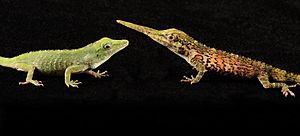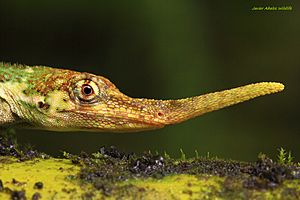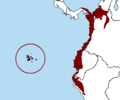Horned anole facts for kids
Quick facts for kids Horned anole |
|
|---|---|
 |
|
| Female (left) and male (right) | |
| Conservation status | |
| Scientific classification | |
| Genus: |
Anolis
|
| Species: |
proboscis
|
The Anolis proboscis, also known as the horned anole or Pinocchio lizard, is a small anole lizard. It belongs to the Dactyloidae family. This lizard is famous for the long "horn" or proboscis on its snout, especially in males.
A male Pinocchio lizard was first found in Ecuador in 1953. Scientists Peters and Orces officially described it in 1956. After that, no one saw the lizard again until it was rediscovered in 2004!
Today, we know it lives in a small area of plants along a highway in Ecuador. The IUCN (International Union for Conservation of Nature) has listed it as an Endangered animal. This is because it lives in a very small area, and its home is slowly disappearing.
Contents
What Does the Pinocchio Lizard Look Like?
The Anolis proboscis has short legs and a small body. Its body, not including the tail, is about 5 to 7.5 centimeters (2 to 3 inches) long.
Male lizards are a bit bigger than females. They have a special, long nose-like part called a proboscis. This "horn" sticks out from the middle of their snout and is about 1 to 2 centimeters (0.4 to 0.8 inches) long. It seems to be used when males try to attract a mate. Both male and female lizards also have a dewlap, which is a flap of skin under their throat.
These lizards come in different colors. Their proboscis can be greenish-yellow to orange-brown. Their bodies can have spots or stripes.
The Pinocchio lizard looks a lot like other "twig anoles." These are lizards that live mostly on thin branches. They have slender bodies, short legs, and short tails. They also have a tail that can grip things, which helps them climb and find food in the trees. Even though they move slowly, they can travel long distances.
The Amazing Proboscis
The proboscis is one of the most interesting parts of the Pinocchio lizard. It's a soft, blunt part that sticks out from the snout. It's about 85% as long as the lizard's head!
Scientists aren't completely sure what the proboscis is for. But they know it's not used for fighting other males because it's too flexible. It might help males look bigger, which could give them an advantage when they meet other males.
Since only males have the proboscis, it's probably not for keeping warm or for hunting food. It's likely used for showing off during mating. The A. proboscis has a small, less colorful dewlap compared to other anoles. So, the proboscis might make up for that, acting as a fancy decoration. It probably helps males communicate with each other and with females. It could also help males show who is in charge or help females choose a mate.
Where Do Pinocchio Lizards Live?
The Anolis proboscis lives in mountain forests in a region called El Chocó in Ecuador. They usually stay high up in trees. Most of the lizards found have been in forests along a busy dirt road.
So far, scientists only know of five places where these lizards live. The farthest two spots are only about 13 kilometers (8 miles) apart. Even though they've been seen in areas where forests have been cut down, they seem to prefer deep forests where they are harder to find.
These lizards can be found at all levels of the rainforest, from the ground to the very top of the trees. But they seem to spend most of their time high up in thick plants, which makes them hard to spot. At night, they sleep on small twigs and leaves, usually between 2.1 and 10 meters (7 to 33 feet) off the ground. This helps them feel the vibrations of any animals that might try to eat them. In the Mindo area of Ecuador, they have been seen in apple trees, bamboo plants, and even in forests that have been disturbed by humans.
Conservation Efforts
The Pinocchio lizard is currently listed as Endangered. This is because it lives in a very small area. Also, its home is being lost due to logging, new human settlements, farming, and grazing animals. Because it's so rare and unique, it's also at risk of being caught illegally for the international pet trade.
After it was first found in 1953, people thought the species might be extinct because no one saw it again for a long time. But in 2004, an ornithologist (bird scientist) saw and photographed one in a cloud forest near Mindo, Ecuador. This was its rediscovery!
In 2009, a group of scientists from the University of New Mexico found five more lizards in a remote part of Ecuador. This included the first two females ever seen and collected! Since 2009, other groups have also found the species in different remote areas of Ecuador.
The Pinocchio lizard might be rare for a few reasons. It could be that it needs a very specific environment, like the tops of cloud forests. Or, it might naturally have small populations.
Life Cycle and Reproduction
Anolis proboscis lizards lay eggs. This means they are oviparous. In zoos or special care, females lay one egg. This egg takes about 165 days (about 5 and a half months) to hatch. Interestingly, male baby lizards are born with their proboscis already formed, and it grows longer as they get older.
How They Find a Mate
Scientists have seen different behaviors related to mating. It was once thought that the proboscis played a role in reproduction, but this isn't fully confirmed. These lizards have a mating system where one male mates with several females. They use many visual signals and movements during the mating process.
To attract a mate, both males and females show off their dewlaps. Males have been seen with their dewlaps out and their proboscis pointing downwards when trying to attract a female. Males can slowly change how stiff and what direction their horns point when they are courting. Other behaviors include swinging their head from side to side (called "proboscis flourishing") and moving their head up and down when they get close to a female. All this happens while their dewlap is partly or fully out.
If the female runs past the male and keeps going in the opposite direction, it means the courtship was successful. This leads to the next stage called chasing. The female might also do a "push-up" with her front legs, bob her head, and extend her dewlap in response to the male.
Chasing starts when the female encourages the male to follow her by running past him. The male then follows the female in quick, short sprints, usually one to three steps long. He bobs his head often, just like in courtship. Chasing ends when the female arches her neck, or when the male starts to climb onto her tail with his front legs. If the male can't follow the female successfully, they won't mate.
Male Conflicts
Male lizards might fight when two of them try to attract the same female. These fights are usually not violent. Males might try to show off to each other, chase the other male away, open their mouths to show their teeth, arch their necks, raise their backs and probosces, and keep their heads down. They might also touch the other male's face with the tip of their snout or slowly wave their tails.
Males have also been seen doing a movement like a push-up. They move their body forward with their head and tail down, then back, raising their head and tail. During this display, their dewlaps are out, their tail is curled up, and their proboscis is straight. These behaviors are meant to scare away other males, perhaps by making the male look bigger. They have also been seen turning sideways and straightening their bodies, and even sticking out their tongues, possibly to make themselves look longer.
Violent fights can happen, including biting and pushing. These fights can last until the other male stops trying to court the female. Unlike many other reptiles with big nose parts, the A. proboscis does not use its proboscis as a weapon. It might even try to protect it during a fight. During violent male-male interactions, the proboscis stays lifted, and some lizards have scars, meaning the proboscis can get hurt.
Overall, this species seems less aggressive than other types of anoles. This fits with the behavior of other "twig ecomorphs." They bite or "jaw lock" much less often than species like A. marcanoi or A. carolinensis.
What Do Pinocchio Lizards Eat?
The Pinocchio lizard eats both plants and animals, so it's an omnivorous animal. Its stomach can hold anywhere from 4 to 16 food items.
They eat many different insects. Their main food sources include caterpillars, beetles, bugs, flies, and hymenoptera (bees and wasps). But they also eat pseudoscorpions, larvae, millipedes, spiders, and different plant parts like flower petals, pieces of wood, and seeds.
Images for kids
See also
 In Spanish: Anolis cornudo de Mindo para niños
In Spanish: Anolis cornudo de Mindo para niños






